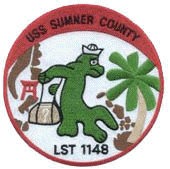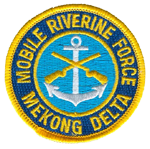LST-1148 was laid down on 15 February 1945 by the Chicago Bridge and Iron Co., Seneca, Ill.; launched on 22 May 1945; sponsored by Mrs. H. M. Fay; and commissioned on 9 June 1945, Lt. Richard Goodhart, USCGR, in command.
LST-1148 moved down the Mississippi River to New Orleans and held her shakedown in Galveston Bay from 19 June to 1 July. Following a short yard availability period, she loaded cargo and stood out of New Orleans on 13 July en route to the Pacific. After transiting the Panama Canal, she called at San Diego and Seattle before arriving at Pearl Harbor on 27 August. She sailed from there for Okinawa on 7 October and arrived at Buckner Bay on the 25th. Three days later, she got underway for Japan and arrived at Sasebo on 30 October.
LST-1148 remained at Sasebo for 18 days during which time most of the cargo was unloaded. She departed Sasebo on 18 November for Okinawa. The remainder of the cargo was offloaded there between 23 and 28 November. The LST stood out of Buckner Bay on 8 December en route to Saipan and arrived there on the 21st. On 27 December 1945, she was routed onward to the United States, via Pearl Harbor, and arrived at San Pedro on 30 January 1946. She moved up the coast to San Francisco; unloaded her cargo; and proceeded to Astoria, Oregon, for inactivation without an overhaul. She was placed in reserve, out of commission, on 11 May 1946 and berthed in the Columbia River.
LST-1148 was placed in commission again on 3 October 1950 at the Naval Base, Astoria, Oregon. After a yard period and refresher training, she steamed to San Diego for further training from 14 December 1950 to 1 March 1951. She then moved to Port Hueneme; loaded cargo; and departed for the Far East on 3 March. The LST arrived at Yokosuka, Japan, on 7 April, and based her operations there. The ship mostly operated in Japanese waters but made two voyages to Inchon, Korea, in October 1951. She returned to San Diego on 19 December 1951. Following a three-month overhaul at San Francisco and refresher training, LST-1148 sailed on 25 August 1952 to begin her second tour in the Far East. She operated between Japanese ports and Inchon, Koje Do, Sokcho-Ri, and Pusan, Korea. She returned to San Diego on 16 May 1953 and commenced local operations, including amphibious landings, along the California cost.
LST-1148 was in the Mare Island Naval Shipyard from 23 November 1953 to 2 February 1954. She returned to her home port for a month of refresher training and, on 27 March got underway for her third tour in WestPac. She arrived in Yokosuka on 25 April and engaged in training operations which took her to Korea and Okinawa. On 17 August, she departed Yokosuka for French Indochina. Between 29 August and 24 September, the ship evacuated over 3,000 refugees from the Haiphong area to Tourane. She returned to Japan on 5 October and to San Diego on 7 November 1954. Her stateside tour was short as she headed westward again on 16 March 1955 to operate in Japanese waters until 19 October before returning home. On 1 July 1955 the LST was formally named USS Sumner County (LST-1148) to honor counties in Kansas and Tennessee.
Sumner County deployed to the Far East again from 28 August 1956 to early May 1957. After a two-month leave and upkeep period at San Diego, she departed on 17 July for Hawaii and Operation “Tradewinds,” returning on 31 August. She left San Diego on 1 October 1957 with two other LST’s on a five-week voyage to Kodiak, Alaska. Sumner County had her annual overhaul at San Diego during January and February 1958 which was followed by refresher and amphibious training exercises prior to her forthcoming deployment. She deployed to the Far East from 6 June to 11 December 1958.
In early 1959, Sumner County was nominated to support the HIRAN project in the Marshall Islands. She spent three months transporting men and equipment of Air Survey Team 9 and the Army Mapping Service between the islands of the Marshall group. The project was completed in May, and the ship returned to San Diego. On 3 November 1959, she sailed to Alaska to participate in Operation “Totem Pole” in the Kodiak area. She then returned to San Diego where she participated in local exercises and fleet amphibious exercises for the next two and one-half years.
Sumner County sailed to Hawaii on 27 August 1962 and participated in amphibious exercises there until 7 November. On 26 December 1962, she again departed for Hawaii to support operations for Commander, Service Forces, Pacific. She supported the Service Forces in Hawaii again from 26 December 1962 to 1 April 1963. In June, she sailed to Alaska to participate in a Bureau of Ships project which lasted until 19 July. The remainder of the year and all of 1964 were spent in exercises off the lower California coast.
Sumner County sailed to Hawaii from 20 January to 17 February and participated in Exercise “Silver Lance.” She was at San Diego for one day and ordered to sail for Hawaii on 18 February. The LST arrived at Pearl Harbor on 1 March. On 20 March, she was routed westward to Okinawa and attached to the 7th Fleet. After steaming to Sasebo for an upkeep period from 4 to 9 April, she then got underway for the United States. The ship was at San Diego from 6 May to 7 July when she again headed west. Sumner County arrived at Pearl Harbor on the 17th and departed for Subic Bay, P.I., two days later. She remained there from 9 to 14 August preparing for a prolonged tour in Vietnam.
Sumner County arrived at Danang on 16 August and began supporting the Coast Guard patrol boats participating in Operation “Market Time”, This duty continued until 27 December 1965 when she began transporting cargo up and down the coast to such ports as Cam Ranh Bay, Phan Rang, Nha Trang, Saigon, and Tuy Hoa. On 20 January 1966 the LST broached in heavy weather at Tuy Hoa, causing hull and shaft damage. She was towed to Sasebo for repairs and dry docked there from 8 to 24 February. Three days later, she was underway for the United States via Pearl Harbor.
Sumner County arrived at San Diego on 30 March. Four months later she was again en route to Vietnam, via Iwakuni, Japan, with elements of Marine Air Group (MAG) 15 embarked. The marines were disembarked at Iwakuni on 19 August, and the ship sailed to Yokosuka for an upkeep period. On 20 September, she sailed for Danang with elements of MAG-17. They were off-loaded at Danang on the 29th; and the Sumner County then began shuttling troops, cargo, and equipment from Danang to Chu Lai in support of the marines there. She sailed for Sasebo on 24 October and thence to the United States, via Pearl Harbor, arriving at San Diego on 13 December 1966.
Sumner County was only away from her home port from 17 May to 11 June 1967 when she transported 100 marines and cargo to Hawaii. She was deployed to WestPac from 7 May to 24 December 1968. During this period she shuttled cargo and supplies from Danang to Tan My and Cua Viet from 25 June to 1 August; 6 August to 3 September; and from 28 September to 3 November. This was the ship’s last period of deployment as it was decided that she would be inactivated.
Sumner County departed San Diego on 29 August 1969 for the east coast and arrived at Orange, Tex., on 19 September, to begin preparations for decommissioning. She was placed out of commission, in reserve, there on 9 October and attached to the Atlantic Reserve Fleet. She was still attached to that fleet as of March 1975.
Awards earned during the Vietnam War: Combat Action Ribbon, Meritorious Unit Commendation, RVN Gallantry Cross with Palm, RVN Civil Action Medal, First Class, with Palm, RVN Campaign Medal with 60’s device and the Vietnam Service Medal with (9) Battle Stars.


